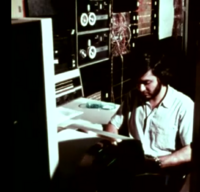Difference between revisions of "PDP-9"
(A comment about PDP-9 microcode I found online. Given the mix of microcode with random logic, I think "diagonal microprogramming" is an apt description.) |
m (→External links: +RICM restoration blog) |
||
| Line 52: | Line 52: | ||
** [http://www.bitsavers.org/pdf/dec/pdp9/DEC-09-I3CA-D-69.pdf TC02 DECtape Control Maintenance Manual] | ** [http://www.bitsavers.org/pdf/dec/pdp9/DEC-09-I3CA-D-69.pdf TC02 DECtape Control Maintenance Manual] | ||
* [https://bitsavers.org/pdf/dartmouth/theses/Blean_-_The_PDP-9_Mini_Time-Sharing_System_197206.pdf Dartmouth PDP-9 Mini Time-Sharing System] | * [https://bitsavers.org/pdf/dartmouth/theses/Blean_-_The_PDP-9_Mini_Time-Sharing_System_197206.pdf Dartmouth PDP-9 Mini Time-Sharing System] | ||
| + | * [https://www.ricomputermuseum.org/collections-gallery/equipment/dec-pdp-9/pdp-9-restoration DEC PDP-9 Restoration] - the start of a long saga - 2012-17 | ||
| + | ** [https://www.ricomputermuseum.org/collections-gallery/equipment/dec-pdp-9/pdp-9-restoration-blog-starting-2019 PDP-9 Restoration Blog Starting 2019] | ||
| + | ** [https://www.ricomputermuseum.org/collections-gallery/equipment/dec-pdp-9/pdp-9-restoration-blog-starting-2020 PDP-9 Restoration Blog Starting 2020] | ||
| + | ** [https://sites.google.com/a/ricomputermuseum.org/home/collections-gallery/equipment/dec-pdp-9/pdp-9-restoration-blog-starting-2021 PDP-9 Restoration Blog Starting 2021] | ||
| + | ** [https://sites.google.com/a/ricomputermuseum.org/home/collections-gallery/equipment/dec-pdp-9/pdp-9-restoration-blog-starting-2022 PDP-9 Restoration Blog 2022] | ||
| + | ** [https://sites.google.com/a/ricomputermuseum.org/home/collections-gallery/equipment/dec-pdp-9/pdp-9-restoration-blog-starting-2023 PDP-9 Restoration Blog 2023] | ||
{{Nav DEC}} | {{Nav DEC}} | ||
Revision as of 03:22, 7 February 2024
| PDP-9 | |
| Manufacturer: | Digital Equipment Corporation |
|---|---|
| Year First Shipped: | 1966 |
| Form Factor: | minicomputer |
| Word Size: | 18 bits |
| Logic Type: | PNP Transistor FLIP CHIPs |
| Design Type: | microcoded |
| Memory Speed: | 1 μsec (9) or 1.5 μsec (9/L) |
| Physical Address Size: | 15 bits (32K words) |
| Virtual Address Size: | 13 bits (direct), 15 bits (extended) |
| Memory Management: | bounds register |
| Predecessor(s): | PDP-7 |
| Successor(s): | PDP-15 |
| Price: | US$30K (8KW system) |
The PDP-9 was DEC's fourth 18-bit computer, and the first DEC CPU to use microcode. A little over 400 were built. It was a re-implementation of the PDP-7; the PDP-9 'Basic Software System' manual indicates that most PDP-7 software will run, un-modified.
Its principal intended use was for real-time systems, including data recording and process control. A variety of models were offered; the basic system provided 8K words of main memory, and the PDP-9/L was a cost-reduced system with cheaper peripherals and 4KW of memory.
It was a load-store architecture, with a single accumulator. Instructions had a 4-bit opcode, 1 bit of indirect, and 13 bits of address. Opcodes 000-060 were memory-reference instructions; for non-memory operations ('074' opcode), and I/O ('070'), bits in the 'address' field were used to specify details. '064' opcodes were for the optional EAE.
For the high-speed ROM needed for a microcoded design, it used hard-wired core memory, similar to that in the Apollo Guidance Computer. Microinstructions were 36 bits wide, of which 6 were the 'control memory address', the address of the next one; there was no micro-PC. Conditional micro-branching was available by modifying the CMA during that microinstruction. Some front panel functions (START, EXAMINE/DEPOSIT (NEXT), and READ IN) are implemented with microcode. According to a comment in the PDP-11 FAQ from Bernd Ullman, "the first intention was to build a horizontally programmed machine but this was dropped because of the resulting word length needed for the control-words. So some(most ?) of the control signals were encoded and this led to a typical diagonally microprogrammed machine I think."
Multiply/divide was a hardware option, the KE09A EAE, which also performed shifting; it was installed in pre-wired slots in the CPU's backplane. Use of more than 8KW of main memory (all core in the PDP-9) required the Memory Extension Control, KG09A, which provided bank switching. A memory management option, the KX09A, was also available; it included a register to set the boundary between protected and un-protected memory, and two modes for the CPU.
The KF09A Automatic Priority Interrupt option provided 8 levels of interrupt priority, each of which could support up to 8 devices. Each device could provide its own interrupt vector. The DM09 Direct Memory Access Channel Multiplexor Adapter provided high-speed devices with direct access to main memory for data transfers.
A large range of peripherals were available, including DECtape (via the TC02 controller), magnetic tape (via the TC59), drum (RM09 controller) and fixed-head disk (RB09; and RS09, via the RF09 controller). The RM09 and RB09 use the DM09.
See also
External links
- PDP-9 - Has manuals for KE09, KG09, KX09, KF09, etc
- Dartmouth PDP-9 Mini Time-Sharing System
- DEC PDP-9 Restoration - the start of a long saga - 2012-17
| v • d • e Digital Equipment Corporation |
|---|
| 18-bit machines - PDP-1 • PDP-4 • PDP-7 • PDP-9 • PDP-15
12-bit machines - PDP-5 • PDP-8 • LINC-8 • PDP-12 36-bit machines - PDP-3 • PDP-6 • PDP-10 16-/32-/64-bit machines - PDP-11 • VAX • MIPS • Alpha Also: Buses • Peripherals • Part numbers • Engineering drawings |
